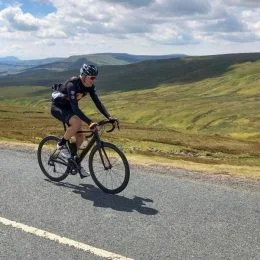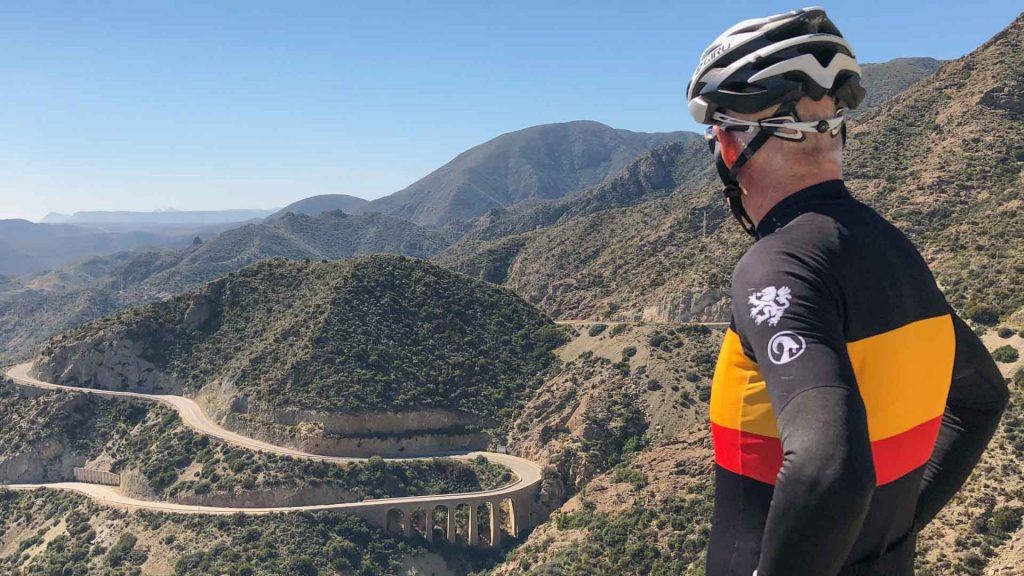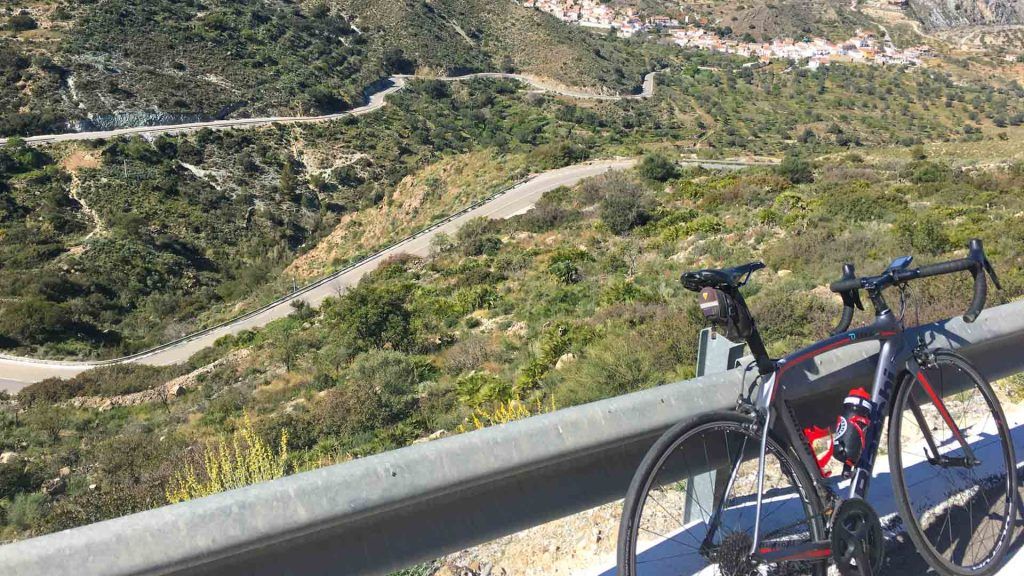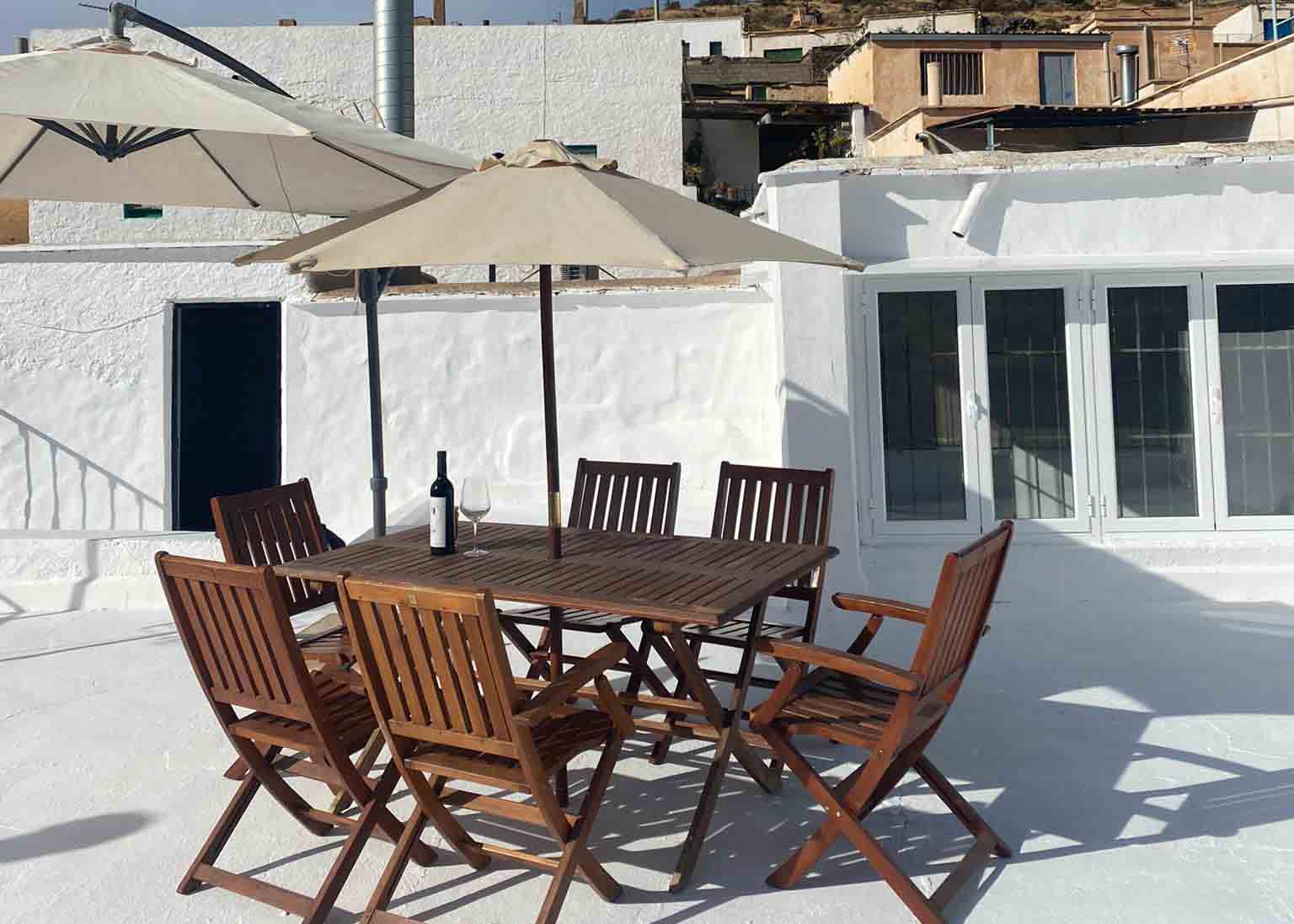Are you looking for the best winter cycling destinations? Heard good things about cycling in southern Spain but not sure where to head?!
It’s time to take a closer look at cycling in Andalucia and, in particular, cycling Almeria. We think it’s one of the best places to cycle in Spain, particularly when it’s cold elsewhere in Europe
This may come as a bit of a surprise: where’s Almeria you might be thinking? How can a cycling destination I’ve never heard of be that good?!
What’s great about cycling Almeria, Andalucia?
As you know, we’ve been lucky enough to cycle in some of the world’s most beautiful cycling destinations. We’ve cycled in most of Spain’s cycling meccas and done many of the ‘big ticket’ climbs made famous by the Tour de France and the Giro.
We think Spain’s province of Almeria offers some of the best cycling in Spain.
It’s something special.
Cycling Almeria, Andalucia: Spain’s best kept secret
The Almeria region is not that well known to those outside Spain. It is quiet, barren and remote in places, but there are good quality roads and it’s sparsely populated. In other words, excellent cycling country.
Almeria is perfect for sunny winter cycling holidays. Cycling in this part of southern Spain offers year round average temperatures between 16 and 22 degrees celsius in the winter months.
It’s little wonder so many professionals get away from the masses and come to train here: the Dutch World Tour outfit, NL Lotto Jumbo, can often be seen in this area getting ready for the start of their season.
Cycling in Almeria offers:
- the weather in Costa de Almeria offers a warm, all year-round cycling climate
- some of Europe’s very best road surfaces
- (pretty much) traffic-free roads
- a variety of challenging climbs, including home to the Velefique, a climb that we think is better than Alpe d’Huez!
- base on the beach of the Costa de Almeria
- good quality hotels
- easy access to nearby airports
- excellent motorway network
- good food.
So, if you’re tired of navigating heavy traffic, exasperated by having to manoeuvre around vehicles and other cyclists on busy, overcrowded climbs then Almeria may be your answer!
Where is Costa de Almeria?
Almeria is a coastal province in the southeast of Spain. It is one of eight provinces that make up the region of Andalusia which runs from Portugal in the west to Murcia in the east.
Costa Almeria sits in between the commercialised areas of the Costa Blanca (e.g. Alicante, Benidorm and Calpe) to the north and Costa del Sol (e.g. Malaga and Marbella) to the south.
[wpgmza id=”19″]
Map showing approximate location of Costa Blanca, Costa Almeria and Costa del Sol (from top to bottom)
Want to visit?
Our guide aims to provide everything you need to plan your cycling trip to Spain’s Almeria region. We share our tried and tested Andalucia cycling routes – you’ll find routes up the Velefique and beyond. You’ll also find our suggestions for where to stay, bike hire and the best time of year to go. Enjoy!
For information on Andalucia cycling tours, read this article.
Almeria cycle routes
Road cycling in Andalucia (well, this part anyway) doesn’t get much press. Yet the province has a topography of tremendous variety – from beautiful Mediterranean beaches, to huge national parks and the Tabernas desert, the only true desert in mainland Europe! This makes for some superb cycling climbs and routes. You’ll find our favourites below.
We had a car to access the inland climbs/routes – we enjoyed the variety of riding that this allowed us.
Must-do Almeria cycling climbs
The Sierra de Los Filabres, to the north of the Tabernas desert, is the largest mountain range in the province covering approximately 30 miles from west to east in a line running north of the city of Almeria towards Mojácar. There are numerous points of crossing the ridge of the range which all create fantastic cycling opportunities of different lengths and gradients.
The Vuelta a Espana came this way as recently as 2017 and combined the two magnificent climbs in the Sierra de Los Filabres: the Puerto de Velefique and Calar Alto. It was a mountain top stage won by Miguel Angel Lopez of Astana who was chased home on the day by Chris Froome and Vincenzo Nibali. There’s more Vuelta history in the Tips section of this guide, below.
Classic Almeria cycle routes
Apart from the two ‘Especial’ Velefique and Calar Alto cycling climbs, there are plenty of other quality routes and climbs in the area, from a beautiful coastal ride through the Parque Natural del Cabo de Gata-Níjar, the popular Puerto de la Virgen climb, the ascent of the Sierra Bedar and, of course, a ride to the much photographed Valley of the Blocks!
Take a look at our guides to these routes below – and don’t miss the map that overlays the routes:
Rides
The map below overlays these three routes, so you can see their location in relation to one another. Click on any route to get the full route information. If your screen size means you can’t see all the routes on your screen at once, click the minus (-) button on the bottom righthand side of the map and it will zoom out.
Where to stay in Almeria (for cyclists)?
Remember to double-check accommodation bike storage arrangements (and any other services you need) before booking as policies often change.
Almeria has well populated coastal resorts with plenty of hotels and restaurants, but behind the coastal strip, the vast majority of the province is barren, rural and remote.
When planning the trip it became evident that in order to find a good hotel we would need to stay on the Mediterranean coast and that if we wanted to venture inland to access the well known climbs then a car would be required to get us near to the foot of some of the climbs.
Almeria is such a big region you will need to drive in some cases an hour or so to get to the foothills of the Sierra Filabres – but there are still excellent routes which can be undertaken directly from the beachfront (see above!).
Mojácar, Costa Almeria
Sitting roughly halfway between the cities of Murcia and Granada, we think the coastal resort of Mojácar on the Costa de Almeria, is a great base for a cycling holiday. It’s within easy reach of serious mountain climbs and quiet roads, yet there’s also the option of relaxing on one of the many golden beaches. The beaches and climate make it a good candidate for a family and cycling holiday.
Mójacar is served to the east by the new Corvera Airport in Murcia (1 hour 30 minutes transfer time) and Almeria Airport to the west (1 hour transfer).
Having selected Mojácar beach as a location for our stay it was quite easy to find a hotel – they are in plentiful supply and in the winter months very competitively priced.
Our choice: Paradores de Mojácar hotel
We opted for the 4 star Paradores de Mojácar, having previously stayed at other hotels in the Paradores chain whilst travelling in Spain.
As you would expect, the hotel was very quiet when we visited in late February. We stayed in a downstairs suite which opened up onto a small terrace which led to the swimming pool area and a large sun terrace which had views over the beach and to the Mediterranean.
 Entrance to the Paradores de Mojácar hotel
Entrance to the Paradores de Mojácar hotel Garden at Paradores de Mojácar hotel
Garden at Paradores de Mojácar hotel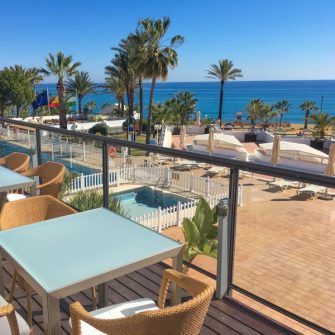 View to the swimming pool area at Paradores de Mojácar hotel
View to the swimming pool area at Paradores de Mojácar hotelWhat we liked
The hotel is well located on the main Paseo del Mediterraneo with only the width of the road separating the hotel from the beach. Road noise was not a problem.
The bedroom was of a good size with a very well equipped large bathroom and an adjoining lounge area with settee and wall mounted flat screen television.
We found the staff to be very accommodating and they provided a room at the rear of the hotel reception area for us to securely store our bikes. There was also ample on site car parking at no additional cost.
We opted for the half board package which consisted of a buffet style breakfast and an a la carte dinner menu in both Spanish and English. They were also happy to swap dinner for lunch if it better suited your needs. The food was good, without being excellent, and perfectly good enough for our needs.
Things to be aware of
The hotel is not really geared for cyclists – but the staff were very helpful and we enjoyed our stay.
Other hotels and places to stay
Servigroup Marina Playa Hotel
There are plenty of hotels in and around Mojácar – but another option right on the beach and in a quiet location is the Servigroup Marina Playa Hotel, which is situated on the same beachfront road we were on, 3 kilometres further north of the Paradores de Mojácar hotel.
The Marina Playa has hosted many World Tour cycling teams over the years and as such offers cyclists a more personalised service with facilities that are more tailored to cycling requirements than the more tourist orientated Paradores. It features a large secure cycle storage area, a repair shop and a bike washroom together with a gym and massage facilities. The hotel will also supply cycling route maps upon request.
Anyone travelling with a group of cyclists would probably find this hotel more suitable for their specific ‘cycling’ needs.
Villa Alegria
54 Sebastian Perez Calle, Gérgal, 04550, Almeria
Website // +34 722 244 464
Villa Alegria is an old, traditionally restored house in the village of Gérgal, tucked away in the beautiful Sierra de los Filabres mountain range.
It has been set up as four individual apartments (each sleeping 4-6 people). Alternatively it can be used as a single house that sleeps up to 20 people. Each apartment has ample inside space for storing your bikes. There are also tools on site for repairs and plenty of outside space for tinkering with them.
Gérgal is on the route up to the famous Calar Alto Astronomical Observatory and the road is usually open all year around. The views on the way up and at the top are quite simply stunning!
Almeria bike hire
Prices, services and bike brands often change. Please let us know if anything is incorrect.
We took our own bikes with us on this trip, so didn’t use the services of these bike hire establishments.
Perhaps due to the lack of cyclists visiting the area from further afield, they don’t give much information about their services online. Contact the stores directly for details – and let us know your experience of hiring a bike in Almeria, in the comments below.
| Bike hire Almeria |
|---|
|
Doltcini Paseo Mediterráneo 124 04638 Mojácar +34 950 092600 |
|
Lufran Bike Sport Calle Mayor, 270B 04630 Garrucha +34 950 122391 |
|
Aguila Bike Ctra. Garrucha-Villaricos. +34 950 133063 |
Best time to visit Almeria
Almeria is the driest part of mainland Europe. It gets over 3,000 hours of sunshine each year. It hardly ever rains, which of course is fantastic news for cyclists!
It is certainly true that the climate in Almeria lends itself to cycling at any time of the year, but our advice would be to stay clear of the summer months of July and August when it’s likely to be very hot and uncomfortable.
Another point to bear in mind is that the temperature on the coast with a gentle breeze may be five or so degrees cooler than some of the places in the Sierra Filabres and the desert area. We noticed even in late February that the temperature increased from a pleasant 19 degrees celsius (with a sea breeze) to a very warm 25 degrees as we climbed the Sierra Bedar with no breeze!
The maximum temperatures in July and August can reach between 30 and 40 degrees around the desert areas.
Note: Mosquitoes are far less common in the winter months than they are in the summer. We didn’t experience any problems with mosquitoes when we visited in February.
| January | Warm weather, even through the coldest months of northern Europe. January is statistically the most wet and cold month (14℃, 27mm of rain over 12 days) – but it’s still mild compared to most places in Europe in that month of the year! Also bear in mind that these temperatures are based on the coast, and temperatures inland are usually warmer. | ||
| February | |||
| March | |||
| April | |||
| May | |||
| June | |||
| July | It will undoubtedly be very warm, and it’s extremely unlikely to rain… but you might well find it unbearably hot inland. Also this is peak season for all those hotels on the coast – so the roads will be much busier than if you were to visit out of season… | ||
| August | |||
| September | Statistically, you might hit some rain in October – December, but temperatures in September and October should remain around (or over) 20℃ and even in November and December, you’re looking at highs that are in double digits. | ||
| October | |||
| November | |||
| December | |||
The average weather information found here was based on the figures in this website.
Tips and articles
Books and maps
This is not a well-known part of Andalucia, and we haven’t come across any particularly useful cycling guides or maps. Let us know if you find any!
Did you know?
Tabernas desert
The Tabernas desert is famous for being the only desert in Europe and for bearing an uncanny resemblance to the wild, barren landscapes of Arizona, California and the Wild West. Since the 1950s, films have been shot here – there are 14 Western villages in the desert (the Fort Bravo village film set is one of the best known) and many great directors have filmed here. Some of the best known films to have come from the region are Lawrence of Arabia and the Indiana Jones movie, The Last Crusade. If you fancy a day off the bike, why not visit Fort Bravo?
Vuelta history
The Vuelta a Espana has not visited the little known, high mountains of the Sierra Los Filabres on many occasions but did go that way in 2004, 2006, 2009 and latterly in 2017.
In 2004 and 2017 the peloton made its way up the Alto de Velefique from Tabernas before accessing the Calar Alto climb from the northwest via the village of Bacares. However in 2006 the organisers took the race up Calar Alto three times before finishing on its third ascent. In 2009 the stage finished at the summit of the Velefique having previously climbed the Calar Alto.
The winner of the 2006 stage Igor Anton described the summit at Calar Alto as ‘like being on the moon’ adding ‘Calar Alto is a very tough climb, but more for the length, than the gradient, and because of the wind, which can be very strong and have a big effect because it’s so open and empty.’ ‘We didn’t go over Velefique in 2006, there are quite a few different approach roads in the area, but I remember from 2009 that I think Velefique was harder than Calar Alto, with some ramps, and the road surface is worse, too.
As you can see both of these climbs represent a serious test for professional and amateur riders alike. We are pleased to add that the road surface has been substantially improved since 2009!
The 2017 stage up Calar Alto which the Irish rider, Nicholas Roche, described as ‘horrible’ saw a scintillating shoot out between Chris Froome, Vincenzo Nibali and the eventual stage winner Miguel Angel Lopez. Watching the age at home on television actually inspired us to visit the area. We are glad we did as it is a fantastic area to go and ride your bike in a tranquil but very challenging environment.
Want to know more about cycling Almeria?
Don’t miss our guides to the best Almeria cycling routes and other articles on this area below.
Want to compare the Costa Almeria with the Costa Brava, Costa Blanca or Costa Daurada? Fortunately we have guides to all three, here: Girona and Costa Brava, Calpe and Costa Blanca and Cambrils and Costa Daurada. You may also like our Q&A on cycling in nearby Murcia.
You can also find information on cycling across Andalucia, between Seville and Valencia, here.
Want to check out some other destinations? Don’t miss our pick of the best cycling destinations in Spain. Alternatively, browse our cycling destination guides, here.
Please support Epic Road Rides
A huge amount of time and effort goes into the article you’ve just read, all with the aim of helping you!
If you found what you’ve read useful, I’d really appreciate it if you dropped something in the tip jar here.
It’s a way you can say thank you and help us carry on creating top quality content with no annoying ads and no pay wall.
Looking for an organised cycling trip?
If you want someone to help you plan and book your cycling holiday, fill out this form. We aren’t a tour operator/agent but we work with lots of people who are and will do our best to put you in touch with someone that can help (within 24 hours where possible)!This article includes details of services that we have used ourselves or which we would consider using. Some are paid adverts. Please read our disclosure policy for further information.
The contents of this website are provided for general information purposes only. It is not intended to amount to advice and you should not rely on it. You should carry out your own due diligence and risk assessments and take professional advice. Views expressed by interviewees or other users of this website do not necessarily represent our views. We make no representations, warranties or guarantees, whether express or implied, that the content on our website is accurate, complete or up to date. If you use any information or content on this website, download from, or otherwise obtain content or services through our website, it is entirely at your own discretion and risk. Epic Road Rides Ltd disclaims all liability and responsibility arising from any reliance placed on the information and content on this website. Find out more here.


